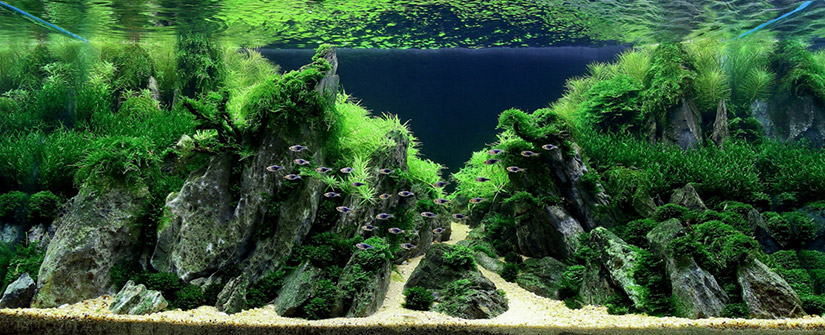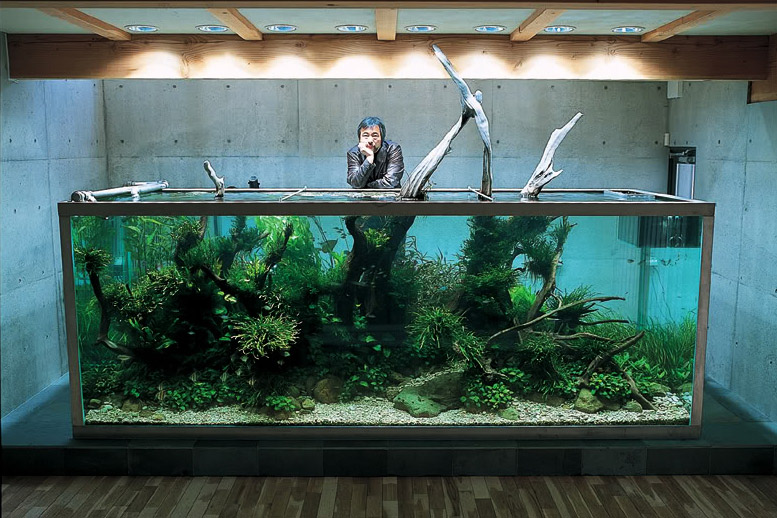

Takashi Amano has become the father of aquascaping. Although he has passed, his vision will remain immortal; Amano expanded a niche to an obsessive global passion. Takashi Amano's brand ADA (Aqua Design Amano) has seen huge success in Japan and the entire globe. But it's Amano's visionary touch reflected in his natural style of aquascaping that receives the most attention. Most notably, the Amazon Inspired 2,400 gallon aquarium that resides in his home in Japan. The Wall Street Journal quotes Amano viewing his masterpiece:
"Lie on your back and look," says Amano, "You feel like you're inside,".
Takashi Amano
 © AquaDesignAmano ADA LTD
© AquaDesignAmano ADA LTDAmanos home lies within the depths of Niigata, a region in Japan, which is surrounded by peaceful rice fields and naturally flowing water. You can tell this is where the inspiration is born. Lightly foliaged trees are dotted over the region. Its crazy quiet. You can only hear nature, it is serenity in it's rawest form.
Amanos aquarium is magnificent. Almost 15 years old and it stands solid and proud. It is utterly amazing how clean the aquarium is, there is no algae, no debris and the gravel looks as though it had been hand polished. Being able to keep a self sustaining ecosystem for that period of time is truly awesome. The aquarium is constantly changing throughout the seasons, the open top allows the driftwood to spill out over the edges of the glass while also allowing the plants to flower in the Spring.
 © Floraquatic
© FloraquaticThe exact dimensions are 4m x 1.5m x 1.5m. The aquarium has it's own automated water change system, custom CO2 injection and constant temperature & pH of 24 degrees and 4.5 respectively. Notable plants include Echinodorus, Rotala Rotundifolia, Microsorum, Red Tiger Lotus & Bolbitis heudelotii. Amano truly replicated a snapshot of the amazon.
To know Mother Nature, is to love her smallest creations
Takashi Amano

Amano didn't begin as an aquarium retailing hobbyist. During the first 17 years of his career he competed in over 1000 professional track cycling races. With savings of around $1.6M from the sport he was able to work his way into the aquascaping scene. Amano Takashi's success is attributed to his early emphasis on the importance of hardscape. Amano carefully selects stones, wood and gravel arranging them in such a way to provoke the audience. The fish themselves are a supporting act and not the focal point of his designs. Amano selects aquatic plants on their merit to 'grow in' to their allocated spaces, their structure, shape and unique colorations. Amano consistently uses small schooling fish in his works to give the illusion of a much larger aquarium.
His notable recent works include the Lisbon Aquariums Oceanarium. A 40m long freshwater exhibition labeled 'Forests Underwater'. It has been widely acclaimed as one of the best examples of modern aquascaping and large scale design.

Takashi Amano went on to produces hundreds of stunning aquariums. What is even more impressive is Amano was never trained nor studied any form of design. Toward the end of his career Amano refused to travel outside of Japan for projects smaller than 13 feet in length. His extreme demand allowed him to pick only projects that appealed to him. He recalls his younger years in which he stayed up until 2-3am perfecting his aquascapes, only to wake up the next morning and hate his own work.
Through his life Amano did try his hand at marine aquariums. Although successful, the difficulty & sustainability of the scapes did not resonate with Amano. Freshwater aquascaping was his true passion.
"I don't do things when I can't win, I can win with freshwater."
Takashi Amano - WSJ

I have always looked up to Takashi Amano. Besides the twinge of jealousy (how can he always get it so right?) I have so much respect for this man and the influence he has had on my life long passion.
“Everyone must leave something behind when he dies, my grandfather said. A child or a book or a painting or a house or a wall built or a pair of shoes made. Or a garden planted. Something your hand touched some way so your soul has somewhere to go when you die, and when people look at that tree or that flower you planted, you're there.
It doesn't matter what you do, he said, so long as you change something from the way it was before you touched it into something that's like you after you take your hands away. The difference between the man who just cuts lawns and a real gardener is in the touching, he said. The lawn-cutter might just as well not have been there at all; the gardener will be there a lifetime.”
Ray Bradbury, Fahrenheit 451
